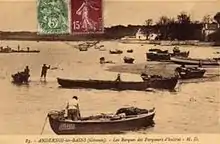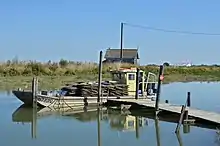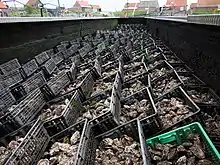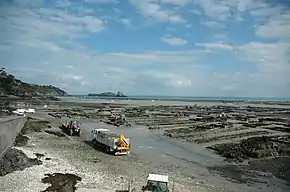.jpg.webp)
Oyster farming is an aquaculture (or mariculture) practice in which oysters are bred and raised mainly for their pearls, shells and inner organ tissue, which is eaten. Oyster farming was practiced by the ancient Romans as early as the 1st century BC on the Italian peninsula[1][2] and later in Britain for export to Rome. The French oyster industry has relied on aquacultured oysters since the late 18th century.[3]
History





Oyster farming was practiced by the ancient Romans as early as the 1st century BC on the Italian peninsula.[4] With the Barbarian invasions the oyster farming in the Mediterranean and the Atlantic came to an end.
In fact, the Romans were the very first to cultivate Oysters. The Roman engineer Sergius Orata is known for his innovative ways of breeding and commercializing oysters. He did this by cultivating the mollusk with a system that could control the water levels.[5]
In 1852 Monsieur de Bon started to re-seed the oyster beds by collecting the oyster spawn using makeshift catchers. An important step to the modern oyster farming was the oyster farm built by Hyacinthe Boeuf in the Ile de Ré. After obtaining the rights to a part of the coast he built a wall to make a reservoir and to break the strength of the current. Some time later the wall was covered with spat coming spontaneously from the sea which gave 2000 baby oysters per square metre.[6]
The Ancient Romans started farming the Thames Estuary in Hampton-On-Sea, or Kent, England from the 1st Century to approximately the 4th Century. They would export the oysters back to Rome and throughout the Roman Empire. Then on July 25, 1864, The Herne Bay Hampton and Recuiver Oyster Fishery Company moved into the area to start oyster farming. In the 1870s the oyster trade suffered from overfishing and sent the industry into a decline. This caused the government of England to make the 1877 Act to solve the problem. This act prevented the sale of dredged oysters from the months of June through August, and freshwater pond oyster sales from between May and August. A couple of years later the company closed its doors and all the assets were sold by 1881, closing the oyster farming in the Thames Estuary area in England.[7] Another place in England that is famous for its oyster fishing is Whistable. The area's “kentish flats” have been used since the Romans started. The oysters would get shipped to Italy, where Roman Emperors would pay for them by their weight in gold. [8]
Varieties of farmed oysters
Commonly farmed food oysters include the Eastern oyster Crassostrea virginica, the Pacific oyster Crassostrea gigas, Belon oyster Ostrea edulis, the Sydney rock oyster Saccostrea glomerata, and the Southern mud oyster Ostrea angasi.
Cultivation
Oysters naturally grow in estuarine bodies of brackish water. When farmed, the temperature and salinity of the water are controlled (or at least monitored), so as to induce spawning and fertilization, as well as to speed the rate of maturation – which can take several years.
The first step to cultivating oysters is conditioning broodstock. Broodstock are the "parent" oysters that will provide gametes for larvae. Oysters in the wild are only "ripe" with gametes for a short window. All of the oysters in an area will spawn at the same time to increase the chances that their gametes meet and fertile larvae are produced. To ensure ripe oysters for spawning throughout the season, some growers choose to keep mature oysters in a separate system where the farmer can manipulate the temperature and food within the system. While a recirculating system can be used, a flow-through system is generally better because the natural diversity of phytoplankton is a better diet for conditioning oysters.[9] By setting up this separate system, the farmer can mimic the transition from winter to summer quicker than real-time, and essentially convince the oyster that it is time to spawn whenever the farmer needs more larvae.
When the farmer actually wants to spawn the oysters, they will put a batch of oysters in a tray and rapidly heat and cool the water to induce spawning. It is important to have a large number of oysters, because it is impossible to tell if an oyster is male or female from its outer appearance. Once the oysters start to spawn they can be picked up and placed into their own separate containers until they have released all of their gametes. Eggs and sperm can then be mixed together to fertilize.[10]
Larvae tanks should be cleaned and disinfected before putting water in the tanks. Water quality should be tailored for the particular species, but most larvae will generally grow faster in warmer water. After the fertilized eggs and beginning-stage larvae have been added to the tank, they should be fed filtered or cultured algae daily, and have their water changed every-other day. This ensures no pathogens or foreign organisms enter the system and compete with or eat the larvae, and their water quality stays pristine to encourage growth. This is the most fragile stage of an oyster's life history.[11]
After about two weeks an oyster will be ready to set. They will develop a small, round discoloration called an eyespot despite not being used for seeing. Their muscular foot will be visible under a microscope. At this point, the larvae can be put in a system with a variety of cultch options. The best cultch is usually full or ground up oyster shell because oysters are naturally attracted to other oyster shell to ensure their future reproductive success.[11] After the larvae settle, they are considered "spat."
Three methods of cultivation are commonly used. In each case oysters are cultivated to the size of "spat," the point at which they attach themselves to a substrate. The substrate is known as a "cultch" (also spelled "cutch" or "culch").[12] The loose spat may be allowed to mature further to form "seed" oysters with small shells. In either case (spat or seed stage), they are then set out to mature. The maturation technique is where the cultivation method choice is made.
In one method the spat or seed oysters are distributed over existing oyster beds and left to mature naturally. Such oysters will then be collected using the methods for fishing wild oysters, such as dredging.
In the second method the spat or seed may be put in racks, bags, or cages (or they may be glued in threes to vertical ropes) which are held above the bottom. Oysters cultivated in this manner may be harvested by lifting the bags or racks to the surface and removing mature oysters, or simply retrieving the larger oysters when the enclosure is exposed at low tide. The latter method may avoid losses to some predators, but is more expensive.[13]
In the third method the spat or seed are placed in a cultch within an artificial maturation tank. The maturation tank may be fed with water that has been especially prepared for the purpose of accelerating the growth rate of the oysters. In particular the temperature and salinity of the water may be altered somewhat from nearby ocean water. The carbonate minerals calcite and aragonite in the water may help oysters develop their shells faster and may also be included in the water processing prior to introduction to the tanks. This latter cultivation technique may be the least susceptible to predators and poaching, but is the most expensive to build and to operate.[14] The Pacific oyster M. gigas is the species most commonly used with this type of farming.
 Oyster culture using tiles as cultch. Taken from The Illustrated London News 1881
Oyster culture using tiles as cultch. Taken from The Illustrated London News 1881 Purpose made oyster baskets
Purpose made oyster baskets
 Oyster farm in South Australia
Oyster farm in South Australia Oyster shucking at Lau Fau Shan, Hong Kong
Oyster shucking at Lau Fau Shan, Hong Kong
Boats
During the nineteenth century in the United States, various shallow draft sailboat designs were developed for oystering in Chesapeake Bay. These included the bugeye, log canoe, pungy, sharpie and skipjack. During the 1880s, a powerboat called the Chesapeake Bay deadrise was also developed.
Since 1977, several boat builders in Brittany have built specialized amphibious vehicles for use in the area's mussel and oyster farming industries. The boats are made of aluminium, are relatively flat-bottomed, and have three, four, or six wheels, depending on the size of the boat. When the tide is out the boats can run on the tidal flats using their wheels. When the tide is in, they use a propeller to move themselves through the water. Oyster farmers in Jersey make use of similar boats.
Environmental impact
The farming of oysters and other shellfish is restorative environmentally, and holds promise for relieving pressure on land-based protein sources.[15] Restoration of oyster populations is encouraged for the ecosystem services they provide, including water quality maintenance, shoreline protection and sediment stabilization, nutrient cycling and sequestration, and habitat for other organisms.[16] Since there has been a decline in oyster population Oyster reef restoration has been huge in the past decades and a native Olympia oyster restoration project has taken place in Liberty Bay, Washington.[17] Oyster farming in the Chesapeake Bay has minimal to positive impacts on the surrounding environment,[18] and numerous oyster restoration projects are underway in the Chesapeake Bay.[19] In the U.S., Delaware is the only East Coast state without oyster aquaculture, but making aquaculture a state-controlled industry of leasing water by the acre for commercial harvesting of shellfish is being considered.[20] Supporters of Delaware's legislation to allow aquaculture cite revenue, job creation, and nutrient cycling benefits. It is estimated that one acre can produce nearly 750,000 oysters, which could filter between 15 and 40 million gallons of water daily.[20]
Other sources state that a single oyster can filter 24–96 liters a day (1–4 liters per hour).[21] With 750,000 oysters in one acre, 18,000,000-72,000,000 liters of water can be filtered, removing most forms of particulate matter suspended in the water column. The particulate matter oysters remove are sand, clay, silt, detritus, and phytoplankton.[21] These particulates all could possibly contain harmful contamination that originates from anthropogenic sources (the land or directly flowing into the body of water).[22] Instead of becoming ingested by other filter feeders that are then digested by bigger organisms, oysters can sequester these possibly harmful pollutants, and excrete them into the sediment at the bottom of waterways.[21] To remove these contaminants from the sediment, species of seaweed can be added to take up these contaminants in their plant tissues that could be removed and taken to a contained area where the contamination is benign to the surrounding environment.[23] More recently, large-scale cultivation of oysters and other shellfish has been proposed as a method to combat climate change, because the growth of the oyster shell sequesters atmospheric carbon dioxide in a form (calcium carbonate) that is stable over geologic time.[24][25][26][27] In The United States, the cultivation of Pacific oysters in tidal areas not only improves water quality in the ocean but oyster cultivation also works to improve government policy. Oyster farming must obey federal regulations, maps, and models. Federal regulation monitors the safety of the environment and the health effects on humans.[28] Carlsbad Aquafarm located in Southern California is cultivating Pacific oysters by using rafts and trays to utilize space to optimize production while operating near the newly opened Claude Lewis Carlsbad Desalination Plant.[29] New adopted environmental impact regulations and policies were created and updated by The United States Environmental Protection Agency, which approved the location and construction of the Claude Lewis Carlsbad Desalination Plant through the federal Clean Water Act on April 7, 2016, whose main focus was minimizing environmental impact in conjunction with Carlsbad Aquafarm.[30] Applications and permits for aquaculture projects such as the Avalon Ocean Farm are made public and required to follow the same guidelines of the EPA and the CWA. Water Quality, Marine Mammals (including endangered species), and forecasted environmental impact evaluations are listed in the project's description to minimize, manage, and mitigate its environmental impact.[31]
Predators, diseases and pests
Oyster predators include starfish, oyster drill snails, stingrays, Florida stone crabs, birds, such as oystercatchers and gulls, and humans.
Pathogens that can affect either farmed C. virginica or C. gigas oysters include Perkinsus marinus (Dermo) and Haplosporidium nelsoni (MSX). However, C. virginica are much more susceptible to Dermo or MSX infections than are the C. gigas species of oyster.[32] Pathogens of O. edulis oysters include Marteilia refringens and Bonamia ostreae.[33] In the north Atlantic Ocean, oyster crabs may live in an endosymbiotic commensal relationship within a host oyster. Since oyster crabs are considered a food delicacy they may not be removed from young farmed oysters, as they can themselves be harvested for sale.
Dermo disease is caused by a protozoan parasite that infects the oyster's blood cells: Perkinsus marinus. It is spread when infective stages are released into the water column from an infected oyster and siphoned into a new host. It is most common in water above 77 °F.[34]
MSX stands for “Multinucleated Sphere Unknown” and is lethal to C. virginica. It is a single-celled protozoan with an unknown method of transmission between oysters. It does not appear to transfer from oyster-to-oyster like Dermo does. After an outbreak in 1997, a strain of MSX-resistant oysters were developed. MSX can be suppressed by low temperatures and low salinities, but once infected, oysters will die within a month.[35]
MSX and Dermo are both considered to be non-harmful to humans. Vibrio, however, is a disease that is carried by oysters and other shellfish and can make people sick, but is not harmful to the oyster itself. Vibrio can only be passed from oysters to humans if they are consumed raw. Vibrio is more common in warmer waters, and all commercial shellfish must be refrigerated before being served in an attempt to kill the vibrio bacterium.[36]
Polydorid polychaetes are known as pests of cultured oysters.[37]
See also
References
- ↑ Higginbotham JA (1997). Piscinae: artificial fishponds in Roman Italy. University of North Carolina Press. p. 247, note 44. ISBN 9780807823293.
- ↑ Bannon CJ (March 2001). "Servitudes for Water Use in the Roman "Suburbium"". Historia: Zeitschrift für Alte Geschichte. 50 (1): 34–52. JSTOR 4436602. For more on these early efforts, see Sergius Orata.
- ↑ Kurlansky M (2006). The Big Oyster: History on the Half Shell. New York: Ballantine Books. p. 49. ISBN 978-0-345-47638-8.
- ↑ Higginbotham JA (1997-01-01). Piscinae: Artificial Fishponds in Roman Italy. UNC Press Books. ISBN 9780807823293.
- ↑ "10 pearls of wisdom about the opulent oyster". BBC. BBC. Retrieved 2 December 2021.
- ↑ Toussaint-Samat M (2009-03-25). A History of Food. John Wiley & Sons. ISBN 9781444305142.
- ↑ Easdown, Martin (2005). Adventures in Oysterville: The failed oyster and seaside development of Hampton-on-Sea. Ramsgate: Michael's Bookshop. ISBN 1-907369-14-7. Retrieved 12 November 2021.
- ↑ "10 pearls of wisdom about the opulent oyster". BBC. BBC. Retrieved 2 December 2021.
- ↑ Utting SD, Millican PF (1997-09-20). "Techniques for the hatchery conditioning of bivalve broodstocks and the subsequent effect on egg quality and larval viability". Aquaculture. 155 (1–4): 45–54. doi:10.1016/S0044-8486(97)00108-7. ISSN 0044-8486.
- ↑ Helm MM, Bourne N, Lovatelli A (2004). "The hatchery culture of bivalves: a practical manual". Rome: Food and Agricultural Organization of the United Nations. Retrieved 2018-04-26.
- 1 2 Wallace R. "Oyster Hatchery Techniques" (PDF).
- ↑ Myer R (Oct–Dec 1948), "Oyster Terms in the Puget Sound Region", American Speech, The American Dialect Society, 23 (3/4): 296–298, doi:10.2307/486938, JSTOR 486938
- ↑ "Oyster Farming in Louisiana" (PDF). Louisiana State University. Archived from the original (PDF) on 3 March 2016. Retrieved 2012-10-01.
- ↑ "Pacific Oyster". Korea/U.S. Aquaculture. Archived from the original on 2008-07-06. Retrieved 2008-08-08.
- ↑ "The Case for Fish and Oyster Farming Archived 2009-05-12 at the Wayback Machine," Carl Marziali, University of Southern California, May 17, 2009.
- ↑ The Nature Conservancy. "Shellfish Reefs at Risk: Critical Marine Habitats". Archived from the original on 2013-10-04.
- ↑ "Recovery of the Olympia Oyster in Kitsap County". USDA Natural Resources Conservation Service. Archived from the original on 2010-10-08.
- ↑ Turner JS, Kellogg ML, Massey GM, Friedrichs CT (2019-11-07). "Minimal effects of oyster aquaculture on local water quality: Examples from southern Chesapeake Bay". PLOS ONE. 14 (11): e0224768. Bibcode:2019PLoSO..1424768T. doi:10.1371/journal.pone.0224768. PMC 6837484. PMID 31697739.
- ↑ Chesapeake Bay Foundation. "RESTORE - Oyster Restoration". Retrieved May 18, 2012.
- 1 2 Brown A (June 10, 2013). "'Aquaculture' shellfish harvesting bill moves forward". Delaware State News. Archived from the original on October 22, 2013. Retrieved June 11, 2013.
- 1 2 3 Rice MA (January 2001). "Environmental impacts of shellfish aquaculture: filter feeding to control eutrophication." (PDF). Marine aquaculture and the environment: a meeting for stakeholders in the Northeast. Falmouth, MA, USA: Cape Cod Press. pp. 77–86.
- ↑ Buschmann AH, Herna'ndez-Gonza' lez HC, Aranda C, Chopin T, Neori A, Halling C, Troell M. "Mariculture Waste Management". In Jørgensen SE, Fath BD (eds.). Ecological Engineering. Encyclopedia of Ecology. Vol. 3. pp. 2211–2217.
- ↑ Neori A, Chopin T, Troell M, Buschmann AH, Kraemer GP, Halling C, Shpigel M, Yarish C (March 2004). "Integrated aquaculture: rationale, evolution and state of the art emphasizing seaweed biofiltration in modern mariculture". Aquaculture. 231 (1–4): 361–91. doi:10.1016/j.aquaculture.2003.11.015.
- ↑ Hickey JP (February 2009). "Carbon Sequestration Potential of Shellfish". University of South Australia.
- ↑ Fodrie FJ, et al. (2017-06-17). "Oyster reefs as carbon sources and sinks". Proceedings of the Royal Society B. Institute of Marine Sciences, University of North Carolina at Chapel Hill, 3431 Arendell Street, Morehead City, NC 28557, USA. 284 (1859): 20170891. doi:10.1098/rspb.2017.0891. PMC 5543224. PMID 28747477.
{{cite journal}}: CS1 maint: location (link) - ↑ Moore D, et al. (December 2020). "Saving the Planet with Appropriate Biotechnology: 2. Cultivate Shellfish to Remediate the Atmosphere". School of Biological Sciences, Faculty of Biology, Medicine and Health, The University of Manchester, UK (retired).
- ↑ Moore D (January 2020). "A biotechnological expansion of shellfish cultivation could permanently remove carbon dioxide from the atmosphere". Mexican Journal of Biotechnology. School of Biological Sciences, Faculty of Biology, Medicine and Health, The University of Manchester, UK . 5 (1): 1–10. doi:10.29267/mxjb.2020.5.1.1. S2CID 212849469.
- ↑ Fisheries, NOAA (2022-04-28). "Pacific Oyster | NOAA Fisheries". NOAA. Retrieved 2022-05-26.
- ↑ "CARLSBAD AQUAFARMS, INC" (PDF). STATE OF CALIFORNIA—NATURAL RESOURCES AGENCY. Retrieved May 26, 2022.
- ↑ "Ocean Plan Requirements for Seawater Desalination Facilities | California State Water Resources Control Board". www.waterboards.ca.gov. Retrieved 2022-05-26.
- ↑ "SPL-2020-00039-TS Avalon Ocean Farm". www.spl.usace.army.mil. Retrieved 2022-05-30.
- ↑ Goedken M, Morsey B, Sunila I, De Guise S (August 2005). "Immunomodulation of Crassostrea gigas and Crassostrea virginica cellular defense mechanisms by Perkinsus marinus". Journal of Shellfisheries Research.
- ↑ "FAO Fisheries & Aquaculture Ostrea edulis". Food and Agriculture Organization of the United Nations. Retrieved 2008-08-06.
- ↑ Sunila I. "Dermo Disease" (PDF). Connecticut Department of Agriculture.
- ↑ Sunila I. "MSX Disease" (PDF). Connecticut Department of Agriculture.
- ↑ Center for Food Safety and Applied Nutrition. "Health Educators - Vibrio vulnificus Health Education Kit Fact Sheet". www.fda.gov. Retrieved 2018-04-26.
- ↑ Simon CA (June 2011). "Polydora and Dipolydora (Polychaeta: Spionidae) associated with molluscs on the south coast of South Africa, with descriptions of two new species". African Invertebrates. 52 (1): 39–50. doi:10.5733/afin.052.0104. S2CID 86711527.
Further reading
- Clark, Eleanor (1964). The Oysters of Locmariaquer. Pantheon Books.
- Ingersoll E (1881). The Oyster Industry. United States Government Printing Office. LCCN 12034550.
External links
- The History of Oyster Culture in BC. (1985). Malaspina College.
- The Oystermen Documentary produced by Oregon Public Broadcasting



